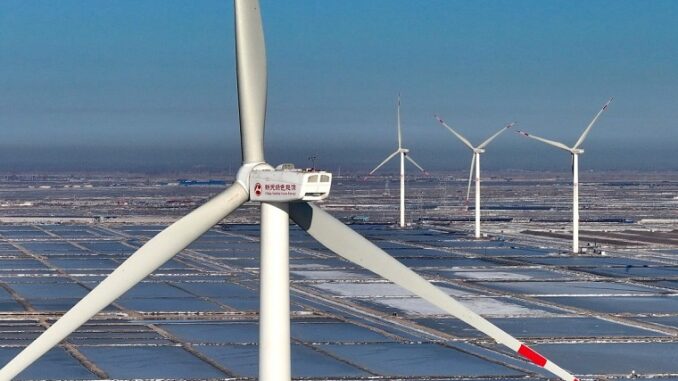
Photo: A wind farm in China’s northern Hebei province. Like solar panels, EVs and lithium-ion batteries, China saw robust growth in exports of wind turbines last year: Xinhua
EU limits on Chinese wind turbines could jeopardise climate targets
On 9 April, 2024 the European Union announced it would launch a subsidy investigation into Chinese wind turbine suppliers in several EU countries, as the bloc steps up trade protectionism against China’s new-energy industries. The wind turbine move probe is the fourth investigation conducted by the EU trade bloc under its new Foreign Subsidies Regulation within two months, with a clear aim to target China’s new-energy companies.
China has strongly protested against the wind turbine move, saying that it showed “the rising tendency of protectionism in the EU.” China also hit back at an updated report by the EU that “distorts China’s policies, market environment and economic system.” The EU report covers various industries in China, including telecoms, semiconductors, railways, renewable energy and new-energy vehicles (NEVs).
The Global Wind Energy Council (GWEC) has said that any restrictions on trade that might result from the European Commission’s anti-subsidy probe into Chinese wind turbine makers could put global clean energy and decarbonisation goals at risk. It further said that trade restrictions could disproportionately affect developing economies, particularly low-income countries, and undermine the aim of a just and orderly transition.
The GWEC noted the wind energy supply chain is highly globalised, which necessitates enhanced collaboration to maintain healthy competition, the most competitive cost of wind energy to the consumer and the highest levels of deployment. Maintenance of global supply chains requires healthy relationships amongst trading partners and cooperation within the global trading system.
The Global Times reports that Chinese analysts see the real aim of Western politicians and media outlets that hype the subsidies and “overcapacity” narrative appears to be the protection of their own clean-energy industries from Chinese competition.
China’s Ministry of Commerce told a press conference that “the EU cannot claim to care about climate change while simultaneously promoting protectionism and restricting international green trade and investment. This double standards approach will hinder the global green transition, disrupt China-EU investment cooperation, and damage mutual economic and trade trust.”
Wind turbines produced by Chinese companies are 20 per cent cheaper than those manufactured by competitors in the United States and Europe, according to BloombergNEF.
The South China Morning Post cited comments by Cosimo Ries, an energy analyst with Trivium China that “Although further tariffs on Chinese wind turbine imports to the EU are possible, the investigation’s impact on Chinese wind turbine makers will be limited”. The EU is a big market, but there are many big markets across the Global South – “Southeast Asia, South Asia, Central Asia and Latin America will still be sizeable markets for Chinese wind turbine makers, where they have a clear advantage over European competitors due to low costs,” Ries said.
As Politico the Washington-based US digital newspaper reminds us, “Europe was once the world’s leader in producing the wind energy increasingly needed to power the world for decades to come. But persistently high inflation, supply chain bottlenecks, and hold-ups in getting permits have local manufacturers fearing Chinese producers could eventually unseat them.”
The EU trade bloc’s energy spokeswoman, Kadri Simson, last year admitted that “In the space of two years, Europe has lost its leadership as the largest world market for wind to the Asia Pacific region … [and] … now this trend starts to be visible also here in the EU.”
Ten years ago the EU tried to impose solar tariffs to prevent China’s rise in that key energy sector. The EU eventually backed down as it lost its global edge on solar production.
Sources:
- Global Times, Apr 11, 2024. https://www.globaltimes.cn/page/202404/1310404.shtml
- Global Wind Energy Council, Apr 15, 2024. https://www.linkedin.com/pulse/gwec-statement-fostering-fair-open-transparent-cbgne
- South China Morning Post, Apr 10, 2024. https://www.scmp.com/business/china-business/article/3258527/eu-investigation-chinese-wind-turbine-exporters-could-lead-higher-costs-slow-down-clean-energy
- Politico, Oct 24, 2023. https://www.politico.eu/article/european-wind-power-package-eu-commission-green-energy-sector-game-changing-china-strength/